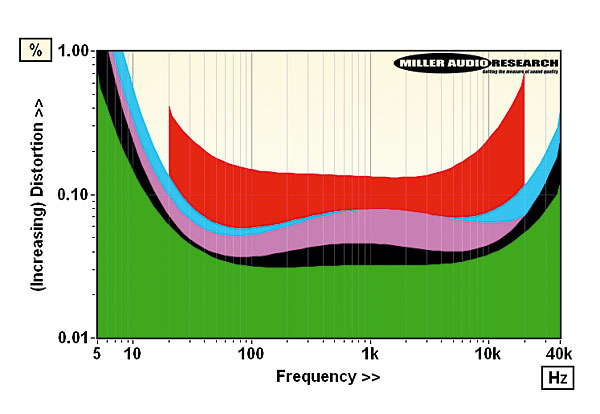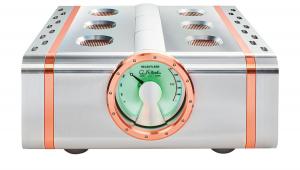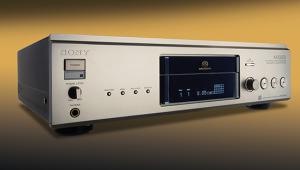Manley Jumbo Shrimp/Mahi Preamp & Monoblocks Lab Reports
Manley Jumbo Shrimp
Anyone who tells you that tube amplifiers are inherently noisy clearly has not sampled Manley's Jumbo Shrimp! Here a trio of 12AT7EH input triodes, 5670 drivers and 5687 output tubes are configured to yield an 'industry standard' gain of 11.9dB with a wide A-wtd S/N of 90.8dB and an unwtd residual noise of just –100.3dBV (9.7µV). Moreover, the Jumbo Shrimp incorporates sufficient headroom to allow a massive 26V output, which is more than enough to drive any hi-fi power amp into clipping (and beyond...). Incidentally, the partnering Mahi power amps require less than 0.5V to reach full output (standard feedback/ultralinear modes) so care must be taken not to feed the Jumbo Shrimp too high a line signal if full use of the volume control is to be realised. Fully analogue volume pots are rare these days but the channel balance is within 0.5dB over the top 60dB of its range – a good result – while crosstalk climbs slowly with frequency, from –92dB/20Hz, –72dB/1kHz to –47dB/20kHz.
The Jumbo Shrimp's response [black trace, Graph 1] is largely unaffected by the position of the (correctly buffered) volume control, reaching down low and up high with ±1dB limits of 3Hz-45kHz and showing just the mildest +0.14dB lift from 10-20kHz. The output impedance is low enough at ~89ohm, increasing to 104ohm at 25Hz [red trace, Graph 1], so the Jumbo Shrimp should prove 'interconnect friendly', aided by the Mahi's high 110kohm input loading. Distortion increases with output and frequency extremes, achieving a minimum of ~0.002% at 200-300mV output in the midrange before rising to 0.004%/1V, 0.01%/2V, 0.03%/5V and 0.065%/10V. Versus frequency, the tubes were better matched in the left channel here [see Graph 2] achieving a very 'flat' ~0.004% from 20Hz-20kHz. PM


| Maximum output (<1% THD, 47kohm) | 26.0Vrms |
| Maximum input level (<1% THD) | >7Vrms |
| Output impedance (20Hz–20kHz) | 89-104ohm |
| Freq. response (20Hz–20kHz/100kHz) | –0.0dB to +0.1dB / –5.4dB |
| Input sensitivity (re. 0dBV) | 255mV |
| A-wtd S/N ratio (re. 0dBV) | 90.8dB |
| Distortion (20Hz-20kHz re. 0dBV) | 0.0040–0.0045% |
| Power consumption | 53W |
| Dimensions (WHD) / Weight (total) | 483x89x279mm / 6.8kg |
Manley Mahi
Despite its compact chassis, and the single secondary output windings/single speaker outputs, the Mahi packs a lot of 'user involvement' onto its polished black top plate. Both ultralinear (UL) and triode modes are offered, the latter connecting the plates and screen grids within each of the EL84 pentodes to achieve an alternate pattern of distortion (that some prefer), a higher output impedance/modified response shape and a reduction in maximum power output. In practice the Mahi achieves 35W/8ohm and 39W/4ohm in UL mode and 20W/24W, respectively, in triode mode, with sufficient headroom to accommodate 36W, 44W, 43W and 35W into 8, 4, 2 and 1ohm, respectively, in UL mode [see Graph 1, below]. Manley's specification of 40W at ~1.5% THD is not wide of the mark but while power output and frequency response are optimised for ~5ohm the Mahi's output impedance is lower and more load-agnostic at <0.75ohm (20Hz-20kHz) than Manley's 2.16ohm rating might suggest. Both UL and triode modes have a –0.55dB/20kHz response into 8ohm and –0.48dB/20kHz into 4ohm, with bass good to a low –3dB/3Hz.
Distortion, on the other hand, is influenced by both UL or triode modes and the 'Min' (3dB), 'Standard' (6dB) and 'Max' (10dB) feedback settings. In UL/standard modes, THD increases from 0.04%/1W to 0.14W/10W and 0.17%/30W, and pitches up through the low bass to 0.07%/20Hz and 0.2%/10Hz at 1W/8ohm [black trace, Graph 2]. 'Max' feedback squeezes THD down to 0.03-0.06%, 'Min' relaxes it to 0.07-0.13% while 'Standard'/ triode mode sits in-between at 0.06-0.1% [all 20Hz-20kHz re. 1W/8ohm; green, blue and pink traces, respectively, Graph 2]. PM


| Power output (<1% THD, 8/4ohm) | 35W (20W) / 39W (24W) |
| Dynamic power (<1% THD, 8/4/2/1ohm) | 36W / 44W / 43W / 35W |
| Output imp. (20Hz–20kHz/100kHz) | 0.73-0.53ohm / 0.93ohm |
| Freq. resp. (20Hz–20kHz/100kHz) | +0.0dB to –0.55dB/–1.25dB |
| Input sensitivity (for 0dBW/40W) | 75mV / 466mV |
| A-wtd S/N ratio (re. 0dBW/40W) | 75.6dB / 91.6dB |
| Distortion (20Hz-20kHz, 10W/8ohm) | 0.14-0.72% (UL; Std. feedback) |
| Power consumption (Idle/Rated o/p) | 90W / 98W |
| Dimensions (WHD) / Weight (total) | 254x127x279mm / 8.2kg |
| Prices | £5849 (preamp)/£7599 (monoblock pair) |























































